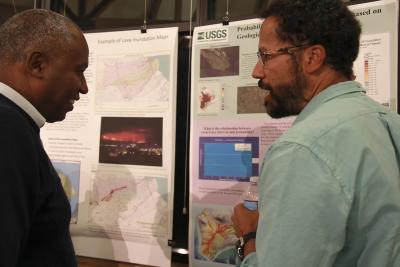International Responses Ensure Readiness at Home

International volcanologists gather to addresses best practices in volcano hazard assessment.
USGS Hawaiian Volcano Observatory geologist Frank Trusdell (right) discusses methodologies for
lava flow
hazard assessment in Hawaii with a volcanology colleague from Ethiopia during the recent Volcano Observatory
Best Practices Workshop in Vancouver, Washington. Eruptions in the East African Rift bear some broad
similarities to Hawaiian volcano rift zone eruptions.
VDAP strengthens the USGS Volcano Hazards Program and the Nation's volcano
disaster risk reduction capabilities in numerous ways. By participating in foreign volcano responses:
-
USGS experts continually hone their skills, gaining the experience required to react to our next domestic eruption.
-
Equipment is continuously modified and improved to address new challenges encountered around the globe.
-
Close collaboration with global volcano observatories results in the development of best practices
that serve as templates for observatory protocols at home.
-
Observations at erupting volcanoes provide insights that inform conceptual models of how volcanoes
work, spark new research efforts, and spur improvements of equipment and forecasting methods that
can then be applied in the United States.
Through VDAP, the USGS earns credibility, worldwide recognition, and otherwise unobtainable experience.
This unique program continues to be a critical element of global volcano disaster risk reduction.
